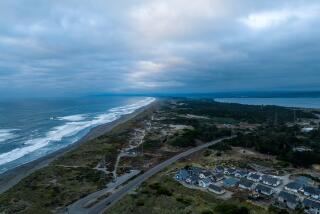Southern California hailed as model of sustainability
- Share via
Southern California is no longer the Great Satan of suburban sprawl. Last month, the Census Bureau released a list of America’s densest urban areas, and Los Angeles-Long Beach-Anaheim ranked first. New York-Newark was fifth.
Nothing symbolizes the emerging shift, however, like the unanimous vote this month by the Southern California Assn. of Governments, or SCAG, to adopt the landmark 2012-2035 Regional Transportation Plan/Sustainable Communities Strategy. With a price tag of $524 billion, it aims to guide growth around public transit and walkable communities. Suddenly, our region is being hailed throughout California as the new model for a sustainable future. The SCAG blueprint exceeds even tough new state standards for reducing greenhouse gas emissions.
The plan includes expansion of housing near public transit by 60%, a 350% increase in funding for biking and pedestrian improvements and projections of more than 4 million new jobs — with public transit within half a mile of most of them. Amanda Eaken of the Natural Resources Defense Council praised it as “the strongest transportation plan” in the history of “car-loving Southern California.” She added that it would save more than “400 square miles of open space — more than a third the size of Yosemite — from development by shifting to a more walkable land use pattern.”
The plan was pushed by leaders across the political spectrum, notably outgoing SCAG President Pam O’Connor from liberal Santa Monica and her successor, Glen Becerra of conservative Simi Valley. The widespread backing from regional business, labor, public health and environmental leaders flouts the caricature of Southern California as a car-loving sea of suburban sprawl.
As the nation’s largest metropolitan planning organization, SCAG controls transportation planning across six counties, encompassing nearly 200 cities. Yet in recent decades, it has stayed under the radar while explosive growth swamped any coherent regional planning.
Efforts to forge a shared vision splintered along the geographic and political fault lines that separate Los Angeles from Orange County, the Inland Empire and high desert. L.A. was building subways and Orange County was widening the 405/5 interchange in El Toro to 26 lanes.
But, as the late economist Herbert Stein dryly noted, “Things that can’t go on forever, don’t.” The devastating real estate meltdown ended the myth of endless expansion. SCAG’s new plan is born of the realization that as a region, we have to grow up, not out. That doesn’t mean Hong Kong skyscrapers in Whittier and Redlands. It does mean more apartments near light-rail stations and more vibrant mixed-use areas like the ones in downtown Pasadena, Ventura and Brea. It doesn’t mean wresting the car keys from suburban commuters. It does mean making jobs and housing accessible via foot, bike, bus and rail.
The plan won’t magically inaugurate a sustainable nirvana. Autumn Bernstein, director of the group ClimatePlan, while commending the plan’s land use vision, cautioned that it “still invests in wasteful and unnecessary road and highway expansions, particularly in outlying Riverside County,” and that “there is a massive shortfall in funding.” More than a third of the projects are unfunded, but this is neither surprising nor fatal. After all, it is a long-term plan.
Such shortcomings aside, the consensus among officeholders and stakeholders will probably grow in this era of nosebleed gas prices and underwater home mortgages. Investing in livable communities may be a stretch, but churning out more tract homes and strip malls is an unaffordable fantasy. As Winston Churchill has often been quoted as saying, “We are out of money — we are going to have to think!”
That’s a challenge. Even if our region collectively ranks as the 15th-largest economy in the world, few of us identify with the abstraction called Southern California. We seldom lift our heads above parochial gripes about potholes, traffic and long commutes. Those are all understandable concerns, but they won’t be fixed without smarter policies, hard work and real money.
With the adoption of SCAG’s plan, we’re seeing smarter policies. Now comes the hard work, including investing real money. But first, the 18 million of us who live here have to accept that we’re no longer the land of freeways and tract houses but a dense metropolis with more that unites than divides us. Then we can turn an ambitious vision into an achievable reality.
Rick Cole is the city manager of Ventura.
More to Read
A cure for the common opinion
Get thought-provoking perspectives with our weekly newsletter.
You may occasionally receive promotional content from the Los Angeles Times.






